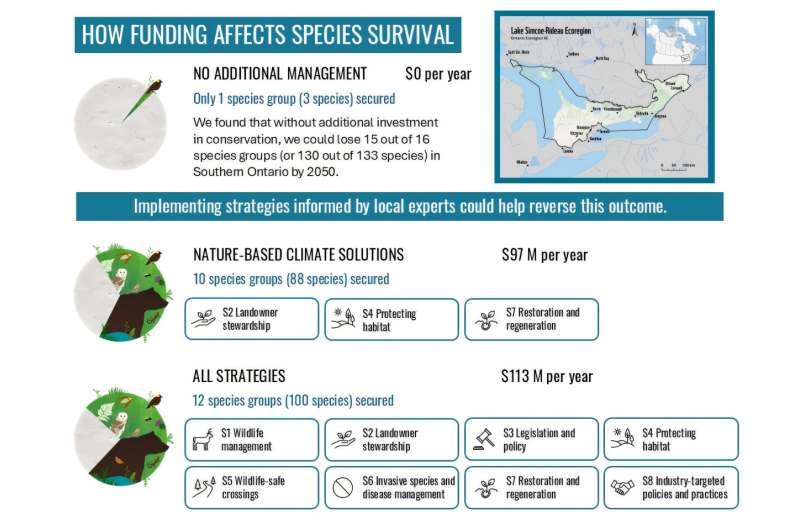A recent study indicates that 130 species in Southern Ontario are at risk of local extinction by 2050 if no new conservation measures are implemented. This alarming finding, published by the University of British Columbia and World Wildlife Fund Canada, highlights the urgent need for action to protect these vulnerable species.
The research reveals that 98% of the at-risk species in the region could disappear without intervention. The study emphasizes that a modest investment of just $7 per Ontarian in eight targeted conservation strategies could significantly aid in the recovery of these species, which include the black bear, the short-eared owl, and the Blanding’s turtle.
Investing in Conservation Strategies
The study, published in the journal Ecological Solutions and Evidence, examined the biodiversity crisis in the Lake Simcoe-Rideau ecoregion, a recognized hotspot for species at risk. Researchers found that without immediate action, 130 of the 133 species identified as declining, at risk, or culturally significant to Indigenous Peoples could vanish by 2050.
To reverse this trend, the research outlines a need for an annual investment of $113 million in conservation efforts. This amount represents less than one-tenth of one percent of Ontario’s projected budget for 2024. Abbey Camaclang, a study author and researcher at UBC’s Faculty of Forestry, stated, “If Ontario continues with a ‘business as usual’ approach, 130 species—98% of those at risk—could disappear from the region by 2050. Our analysis shows recovery is possible and identifies the most cost-efficient ways to achieve it.”
The eight conservation strategies proposed include wildlife management, landowner stewardship, habitat protection, legislation and policy reform, wildlife-safe crossings, and invasive species management.
The Importance of Priority Threat Management
The researchers utilized a decision-making tool called Priority Threat Management (PTM), developed by Dr. Tara Martin and her team. PTM leverages local expertise to assess costs, benefits, and feasibility, permitting the identification of actions that yield the greatest biodiversity gains for the least expense. Dr. Martin, a senior author and professor at UBC, explained, “In Canada, we have 864 species at risk of extinction and no costed plan to save them. PTM identifies how to maximize our resources and pinpoint the funding shortfall needed to give these plants and animals the best chance of recovery.”
Implementing the strategies detailed in the study could also yield additional benefits, such as improved water quality, job creation, and enhanced carbon storage. Specifically, the conservation efforts could potentially avoid at least 11.2 million tonnes of CO2 equivalent emissions and sequester 137.6 million tonnes of CO2 equivalent, thus contributing to Ontario’s long-term greenhouse gas reduction goals.
James Snider, vice president for Science, Knowledge, and Innovation at WWF-Canada, highlighted the pressing need for action: “PTM underscores the urgent need for action in Ontario, especially as environmental protections like the Endangered Species Act face challenges. Without new investments and robust legislation, we risk losing species such as the American bumblebee, barn owl, Eastern wolf, and piping plover. This would weaken ecosystems essential to communities’ well-being and livelihoods.”
The findings of this study resonate beyond Ontario, as UBC and WWF-Canada have also applied the PTM framework in other regions, such as the Wolastoq watershed in New Brunswick. There, WWF-Canada has collaborated with local partners to restore over 5,300 hectares of habitat and plant more than 31,000 trees and plants.
As the research indicates, immediate action is crucial to safeguard Ontario’s biodiversity. By adopting the most effective conservation strategies, decision-makers have the opportunity to protect not only endangered species but also the ecosystems that sustain communities and the environment.
For further details, refer to the study by Abbey E. Camaclang and colleagues titled, “Nature requires investment: Applying priority threat management to support biodiversity and climate targets,” published in Ecological Solutions and Evidence in 2025.







